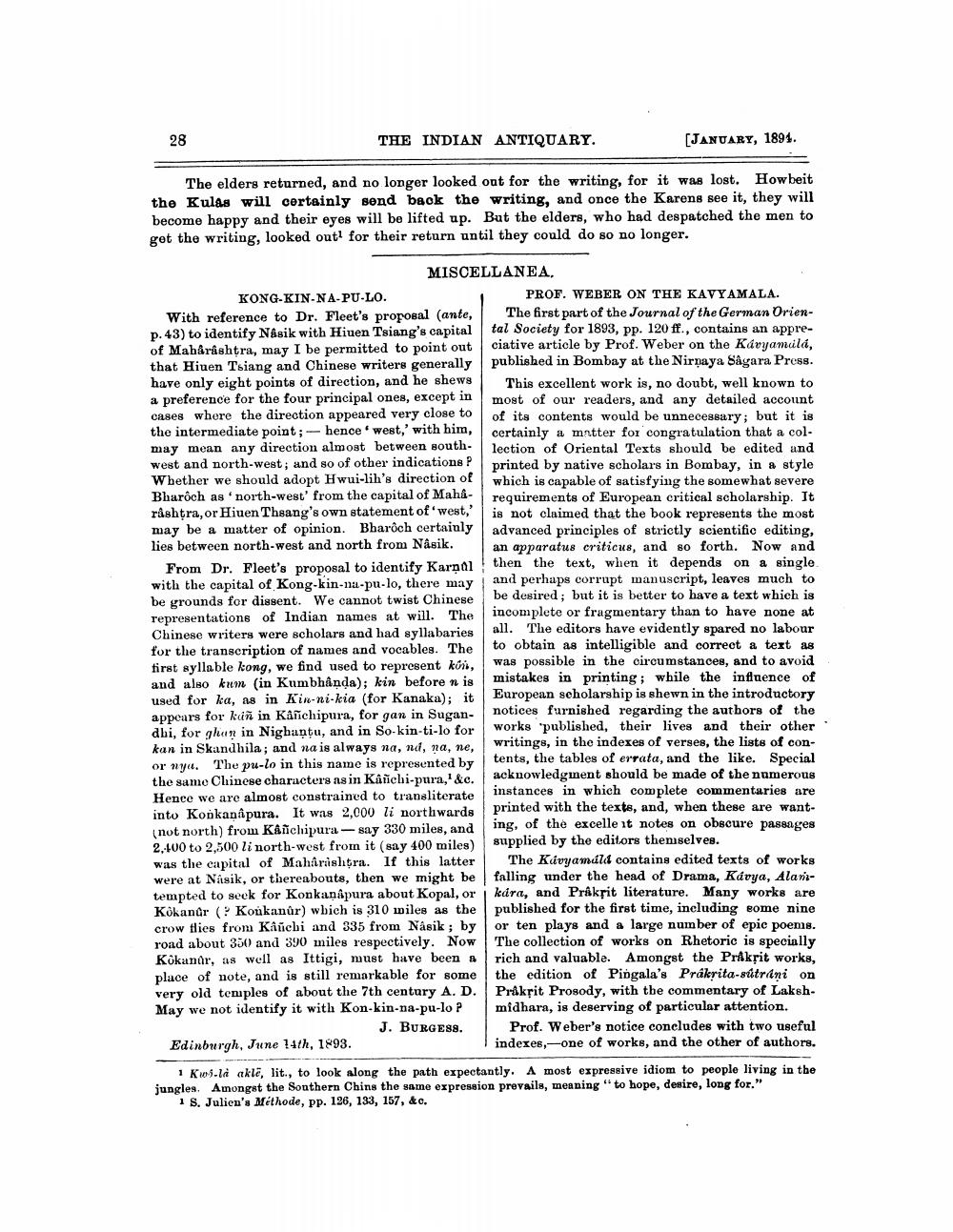________________
28
THE INDIAN ANTIQUARY.
[JANUARY, 1894.
The elders returned, and no longer looked out for the writing, for it was lost. Howbeit the Kulas will certainly send back the writing, and once the Karens see it, they will become happy and their eyes will be lifted up. But the elders, who had despatched the men to get the writing, looked out1 for their return until they could do so no longer.
MISCELLANEA,
KONG-KIN-NA-PU-LO.
With reference to Dr. Fleet's proposal (ante, p. 43) to identify Nasik with Hiuen Tsiang's capital of Maharashtra, may I be permitted to point out that Hiuen Tsiang and Chinese writers generally have only eight points of direction, and he shews a preference for the four principal ones, except in cases where the direction appeared very close to the intermediate point; hence west,' with him, may mean any direction almost between southwest and north-west; and so of other indications? Whether we should adopt Hwui-lih's direction of Bharôch as north-west' from the capital of Maharashtra, or Hiuen Thsang's own statement of west,' may be a matter of opinion. Bharôch certainly lies between north-west and north from Nâsik.
From Dr. Fleet's proposal to identify Karnal with the capital of Kong-kin-na-pu-lo, there may be grounds for dissent. We cannot twist Chinese representations of Indian names at will. The Chinese writers were scholars and had syllabaries for the transcription of names and vocables. The first syllable kong, we find used to represent ko, and also kum (in Kumbhânḍa); kin before n is used for ka, as in Kin-ni-kia (for Kanaka); it appears for kun in Kanchipura, for gan in Sugandhi, for ghan in Nighantu, and in So-kin-ti-lo for kan in Skandhila; and na is always na, na, na, ne, or nya. The pu-lo in this name is represented by the same Chinese characters as in Kâñchi-pura,' &c. Hence we are almost constrained to transliterate into Konkanapura. It was 2,000 li northwards (not north) from Kanchipura-say 330 miles, and 2,400 to 2,500 li north-west from it (say 400 miles) was the capital of Maharashtra. If this latter were at Nasik, or thereabouts, then we might be tempted to seek for Konkanapura about Kopal, or Kokanûr ( Konkanûr) which is 310 miles as the crow flies from Kâñchi and 335 from Nâsik; by road about 350 and 390 miles respectively. Now Kokanûr, as well as Ittigi, must have been a place of note, and is still remarkable for some very old temples of about the 7th century A. D. May we not identify it with Kon-kin-na-pu-lo ? J. BURGESS.
PROF. WEBER ON THE KAVYAMALA. The first part of the Journal of the German Oriental Society for 1893, pp. 120 ff., contains an appreciative article by Prof. Weber on the Kavyamalá, published in Bombay at the Nirnaya Sagara Press.
This excellent work is, no doubt, well known to most of our readers, and any detailed account of its contents would be unnecessary; but it is certainly a matter for congratulation that a collection of Oriental Texts should be edited and
printed by native scholars in Bombay, in a style which is capable of satisfying the somewhat severe requirements of European critical scholarship. It is not claimed that the book represents the most advanced principles of strictly scientific editing, an apparatus criticus, and so forth. Now and then the text, when it depends on a single. and perhaps corrupt manuscript, leaves much to be desired; but it is better to have a text which is incomplete or fragmentary than to have none at all. The editors have evidently spared no labour to obtain as intelligible and correct a text as was possible in the circumstances, and to avoid mistakes in printing; while the influence of European scholarship is shewn in the introductory notices furnished regarding the authors of the works published, their lives and their other writings, in the indexes of verses, the lists of contents, the tables of errata, and the like. Special acknowledgment should be made of the numerous instances in which complete commentaries are printed with the texts, and, when these are wanting, of the excelle it notes on obscure passages supplied by the editors themselves.
The Kavyamálaá contains edited texts of works falling under the head of Drama, Kavya, Alamkára, and Prakrit literature. Many works are published for the first time, including some nine or ten plays and a large number of epic poems. The collection of works on Rhetoric is specially rich and valuable. Amongst the Prakrit works, the edition of Pingala's Prakrita-sútráni on Prakrit Prosody, with the commentary of Lakshmidhara, is deserving of particular attention.
Prof. Weber's notice concludes with two useful indexes, one of works, and the other of authors.
Edinburgh, June 14th, 1893.
1 Kw5-là akle, lit., to look along the path expectantly. A most expressive idiom to people living in the jungles. Amongst the Southern Chins the same expression prevails, meaning "to hope, desire, long for."
1 S. Julien's Méthode, pp. 126, 133, 157, &c.




